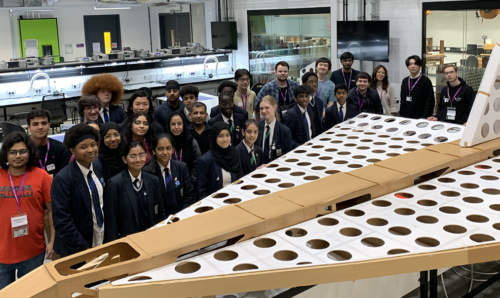Ada Lovelace Day: Resetting the balance for women in STEM
Social responsibility 9th October 2018
Women of STEM and their achievements often go under the radar. After all, while Alan Turing was breaking the German Enigma, star of the silver screen Hedy Lamarr was taking a holiday from Hollywood and inventing a radio guidance system upon which modern-day Bluetooth and Wi-Fi are based.
And while in 2004 Prof Andre Geim and Prof Kostya Novoselov may have won the Nobel Prize for isolating the notoriously strong graphene, Stephanie Kwolek invented Kevlar – a flame and corrosion-resistant material that’s stronger than steel – 40 years earlier.
Ada Lovelace Day helps to reset the balance. Named after the woman who played an instrumental role in the development of modern-day computer programming (Alan Turing was working from her notes nearly 100 years after she died), today is the day to shout about the achievements of women in science and engineering.
And it’s vital that the accomplishments of women in STEM are acknowledged, not only to give them the recognition they deserve, but also to inspire the next generation of female engineers, scientists and mathematicians. Because, as we’ve noted before, between the ages of 10 and 11 the representation and engagement of girls in these classes “drops off a cliff”.
Here come the girls

Research conducted by the Institute of Physics previously revealed that girls make up just one in five of the Physics A-level students in classrooms around the country. It is little surprise, then, that this same figure is seen in the female to male ratio of Physics degree students in the UK.
The dropout of girls from science classes and, later, women from STEM industries is known as the ‘leaky pipeline’. Work is being done to address this, such as the WISE campaign Bring Your Daughter to Work Week, in which our Faculty participates.
From an early age girls often struggle with confidence and are particularly worried about failing, which can mean they avoid asking questions or volunteering answers in the classroom. And of course, science and engineering is all about asking questions, getting things wrong and looking for solutions. The aim of the Bring Your Daughter to Work event is to provide girls with an environment where they’re encouraged to be curious, ask questions and – perhaps most importantly – to fail.
Failing is winning

This thinking is echoed in a joint report released this week by The University of Manchester and the Royal Academy of Engineers, which suggests that primary school teachers should encourage their pupils to “embrace failure”. By doing so, schoolchildren can draw on a range of skills to come up with a practical way to solve the problem – which is key in engineering.
By changing the approach to how engineering is taught in the classroom, the current shortfall of engineers could be reduced. It is estimated that the engineering sector is currently short of as many as 20,000 engineering graduates a year.
While work is being done to encourage more girls to stick with STEM in education, what of women in STEM careers? A recent blog post for Policy at The University of Manchester by Dr Diane Harris and Dr Maria Pampaka – lead project investigators for the Futures in Engineering initiative – highlighted the need for cultural change not only in the teaching of STEM subjects, but also in how society perceives engineers. One particular issue highlighted by the authors is how gender stereotyping may partly be to blame for so few women pursuing careers in STEM – and particularly engineering.
“Undeniably, women are equally as capable as men at performing well in mathematics, but they can be adversely affected by the negative gender stereotype i.e. preconceived ideas which arbitrarily assign characteristics and roles to women (and men) that are determined and restricted by their gender,” the authors note. They include examples such as men having “better” spatial awareness and being “better at map reading”. This may help explain why fewer than one in 10 of the professional engineers working in the UK right now are women.
This Ada Lovelace Day, we are proud to recognise the achievements of all our female scientists and engineers, both past and present. Women like:
 Beatrice Shilling
Beatrice Shilling
A motorcycle racer AND a war hero – Beatrice Shilling is a name we really think more people should know. One of the first women to enrol on an electrical engineering course at Manchester’s Victoria University, she went on to invent a device that stopped the Spitfires flown by the Allied forces from stalling when they went into nosedive.
 Carole Goble
Carole Goble
Our own Professor Carole Goble was the first person to be awarded the Microsoft Jim Gray Award for outstanding contribution to e-science. She also established myGrid, which spans both theory and practice and focuses on data intensive e-science.
 Danielle George
Danielle George
Professor Danielle George is certainly busy. When she’s not igniting passion and excitement for engineering and science on the TV, the Professor in Microwave Communication Engineering can be found doing exactly the same right here. She’s also our Faculty’s Associate Dean for Teaching and Learning AND was recently announced as the Deputy President of the Institution of Engineering and Technology too.
 Alice Larkin
Alice Larkin
Astrophysicist and climate change expert Alice Larkin is another one of our Professors who’s certainly keeping busy right now. Prof Larkin’s research is focused on helping different areas of the economy reduce CO2 emissions and tackle climate change. She has recently been announced as the Vice Dean and Head of the Faculty’s new School of Engineering.
Words – Hayley Cox
Images – The University of Manchester
Ada Lovelace DayBring Your Daughter to WorkSTEMwomen in engineeringwomen in scienceWomen of STEM




